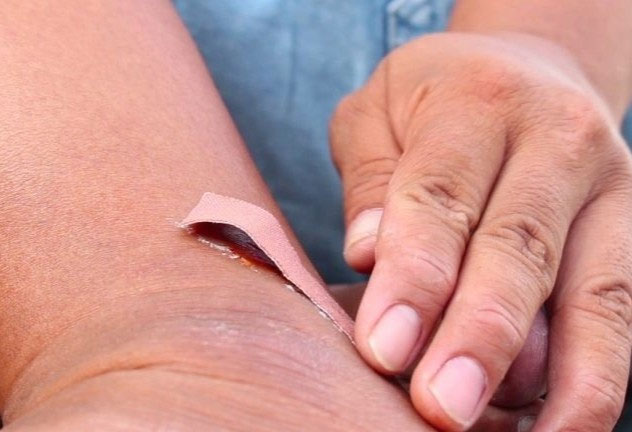Minor injuries such as skin abrasions, cuts, and stepping on nails may seem trivial, but if not treated properly, the risk of infection from tetanus is significantly high.
Tetanus is an infectious disease caused by the Clostridium tetani bacteria. The bacteria enter the body through wounds in the form of spores and thrive in anaerobic conditions.
Once inside, the bacteria release neurotoxins that affect the nervous system, spreading through the nervous system, bloodstream, and lymphatic system, ultimately invading the neuromuscular synapses and the autonomic nervous system, leading to various clinical manifestations.

Every year, sporadic cases of tetanus still occur in our country. (Photo: Bankpezeshkan).
The expanded vaccination program for children under one year old began in Vietnam in 1981, and by 1989, over 90% of communes had implemented it. Thanks to this program, Vietnam has significantly reduced the risk of tetanus and severe tetanus in newborns, children, and young adults.
However, sporadic cases of tetanus continue to occur each year, primarily affecting middle-aged and elderly individuals who have not received vaccinations or have not been fully vaccinated against tetanus.
If tetanus is not detected and treated promptly, it can quickly progress to severe muscle stiffness, generalized seizures, respiratory failure, and even cessation of breathing. Treating severe tetanus cases requires intensive care, prolonged mechanical ventilation, and may lead to various dangerous complications.
Currently, the best way to prevent tetanus remains to be vaccination and proper management of wounds that may be at risk of tetanus infection.
Wound Management
At-risk injuries include deep wounds, those contaminated with dirt, dust, human or animal feces, crushed wounds, or injuries from unsafe injections (using unsterile syringes).
Initial management of deep, dirty wounds must be performed correctly:
- In addition to stopping any bleeding, you should rinse the wound with saline or clean water to remove dirt and debris if present. For wounds with many crevices, bleeding, or significant contamination with dirt or sand, thorough cleaning may require surgical debridement and the use of hydrogen peroxide, typically needing treatment at a medical facility.
- Wounds from animal bites should be washed with soap. Afterward, you can apply appropriate antiseptic solutions and gently bandage with sterile medical bandages. Do not cover the wound tightly if it has not been properly cleaned, as tetanus bacteria can thrive in anaerobic, closed environments.
Regular monitoring, changing dressings, and checking the wound daily are also crucial. If the wound shows signs of purulent infection, individuals should remove the bandage, clean the area, leave it open, or seek medical intervention for thorough treatment. Absolutely avoid using folk remedies like applying leaves or sprinkling powders.
In addition to wound care, you should receive tetanus prophylaxis for crushed or dirty wounds. This includes administering tetanus antitoxin (TAT) for those who have not been fully vaccinated or if it has been over 10 years since their last vaccination. Following this, individuals should also receive a booster shot of the tetanus vaccine as recommended by vaccination units.
Tetanus Vaccination Schedule
According to the vaccination center at the Central Tropical Diseases Hospital, tetanus vaccination is recommended for everyone, especially high-risk groups: farmers, livestock breeders, and intravenous drug users.

The best way to prevent tetanus remains vaccination and proper management of wounds at risk of tetanus infection. (Photo: Wikihealth).
Adults at risk who have not been vaccinated or have not received complete tetanus vaccinations can take proactive measures by receiving the primary vaccination series. This primary series consists of three doses, with the first two doses spaced at least one month apart, and a booster shot given 6 to 12 months after the second dose, followed by boosters every 10 years.
For adults who have received the complete three-dose series 5 to 10 years ago, if they sustain a large wound with a risk of tetanus, they need a booster shot. If it has been more than 10 years since their last booster, they must receive a booster shot even for small, clean wounds. For large wounds with a risk of tetanus, individuals should receive an additional vaccine dose combined with tetanus antitoxin (TAT).
For children, the tetanus vaccine is included in the national expanded vaccination program’s 5-in-1 vaccine. Children will receive three doses of the 5-in-1 vaccine within their first year and a booster at 18 months. If using service vaccines, the booster at 18 months can also be administered using the 5-in-1 or 6-in-1 vaccine. After that, children should receive a tetanus booster between the ages of 4 to 6 and continue to have boosters every 10 years.
Pregnant women are also advised to receive tetanus vaccination proactively before pregnancy and during each pregnancy. For the first pregnancy, the mother will receive two doses of the tetanus vaccine, spaced at least one month apart and one month before delivery for optimal vaccine efficacy. From the second pregnancy onward, each time the mother becomes pregnant, she needs to receive one dose of the tetanus vaccine.


















































